Chapter 3: Migration
3.3 Global and Regional Migration Patterns
Improvement in technology such as better access to information, transportation, and telecommunication such as GPS maps on cell phones accelerated international migration in recent years. This in turn accelerated the diffusion of cultural traits such as ideas, genetic footprints, diseases, cooking styles, and sports across the globe.
3.3.1 Global Migration – A Quick Overview
The three pillars a global economy rests on include trade in goods and services (the production of goods in one country and their consumption in another), foreign direct investment, or FDI, and capital flows, and migration. Migration contributes to human development by reducing global inequalities in the long term. migrants bring much-needed labor and human capital, new ideas, and cultures; and, depending on the country, they may quickly catch up and surpass some of their new country’s citizens in terms of income and social mobility.
In terms of regions, Europe takes in the most migrants followed by Asia, North America, Africa, South America and finally Australia. In many cases, emigrants return to their countries of origin where they can have a dramatic impact on economic and political development, often becoming transnationals shuttling between countries of origin and destination, and a brain drain can turn into a brain gain.
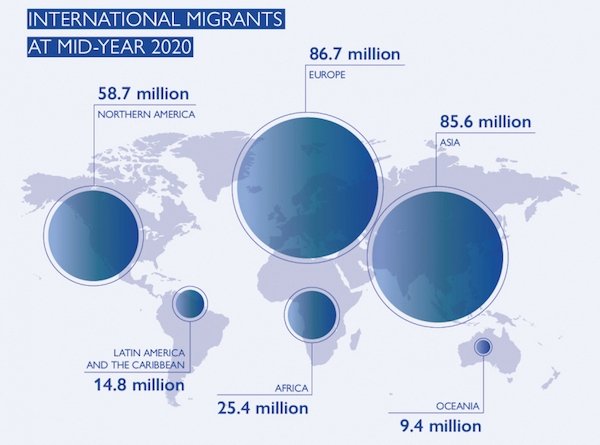
Source: United Nations Department of Economic and Social Affairs, Population Division (2020). International Migrant Stock 2020.
The number of refugees has risen to 35 million from 15 million in 2011 and more than half of refugees come from just three countries: Syria, Ukraine and Afghanistan.

Source: “Map 2 – Refugees, people in refugee-like situations and Venezuelans displaced abroad | end-2021” in “Global Trends Report 2021.” UNHCR, June 16, 2022. Retrieved from https://www.unhcr.org/media/global-trends-report-2021
Turkey is home to the most refugees in the world. It hosts 3.8 million people, the majority of whom are Syrians who fled the civil war. Iran is second, with 3.4 million refugees, mostly Afghans. Columbia, Germany and Pakistan round out of the top five.
3.3.2 Europe
In Europe, movement within and to the European Union (EU) accelerated in recent decades for two reasons:
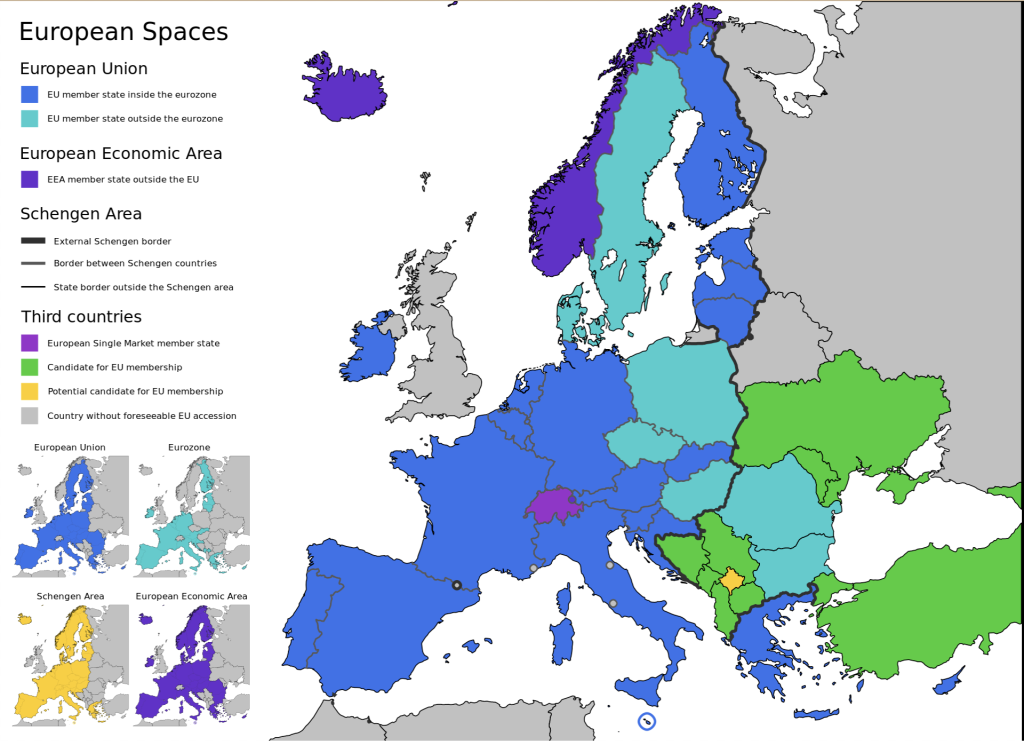
Source: “European Spaces Map” by Discombobulates via Wikimedia Commons is licensed under CC BY 4.0.
1. Intergovernmental organizations like the EU require countries to cooperate on matters such as the economy, human rights, and the environment in order to become and remain EU members. Specifically, some EU members are also signatories of the Schengen Agreement, which enables people, goods, and services to move across international borders without regular security checks.
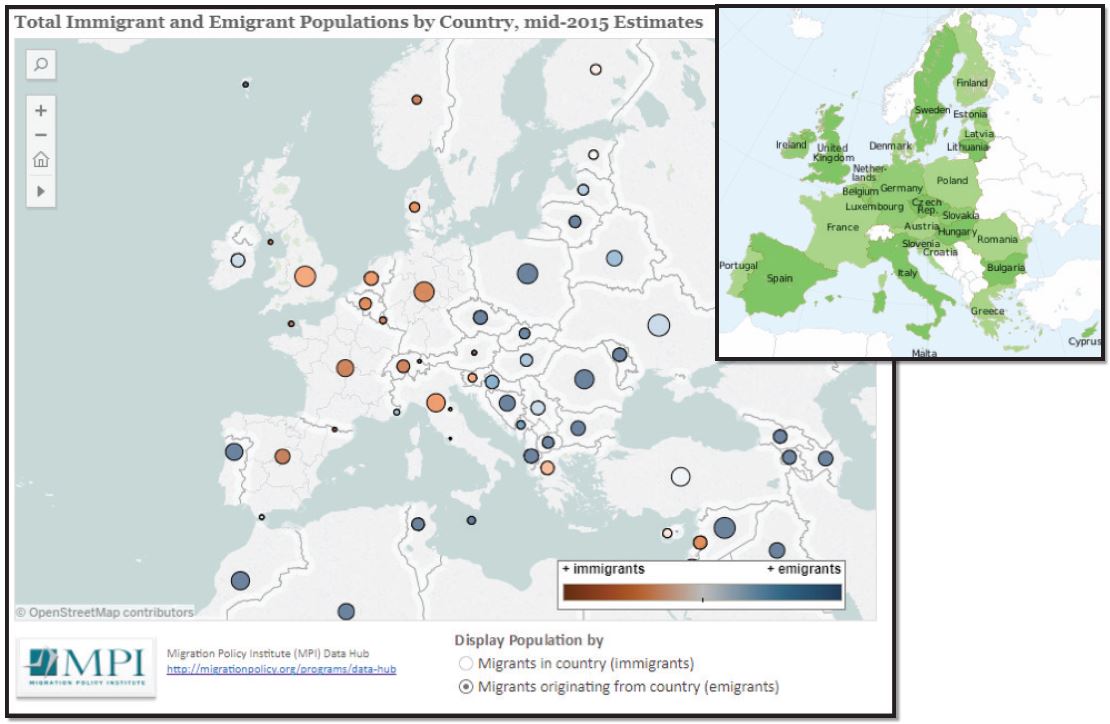
Source: Figure (left) by OpenStreetMaps and Migration Policy Institute via Migration Policy Institute is licensed under ODbL | Figure (right) by “Ssolbergj” via Wikimedia Commons is licensed under CC BY SA 3.0.
Consistent with Ravenstein’s “Laws of Migration,” most international moves continue to take place across relatively short distances. In no place is this more evident than in Europe, where it also quite common to find Spaniards in France, Germans in Switzerland, Romanians in Germany, etc. As portrayed in the map above, movement within Europe tends to be from East (blue dots) to West (red/orange dots) (Figure 3.3.4). Given the ease of travel within, the small size of, and short distances between many European countries, it is not surprising that many people move across borders for a variety of reasons. Of the 48.8 million (numbers of 2023) residents of the European Union (EU), about 10 percent (42.4 million) are foreign born, of which 35 million originate outside of the EU and 19 million moved from one EU country to another. Movement within and to the EU has accelerated in recent decades for two reasons. First, Europe has intentionally worked towards greater economic integration and cooperation since WWII by removing barriers to movement. Citizens and legal residents of participating EU member states may travel, live, study, and work seamlessly across national borders under the Schengen Agreement (Figure 3.3.3). While the EU facilitates the free movement of capital, products, and services in the region, the agreement permits the free flow of people across international borders without significant delay, hassle, or regular security checks. Millions of working-aged residents of Poland, Romania, and Bosnia, for example, have moved to countries like Germany, France, and Spain for higher wages. In some ways, the European region has become similar to the US in that Spaniards may travel to France just as easily as Californians may travel to Oregon.
2. Migrants from non-EU countries (e.g. Ukraine), and other continents such as Africa (Nigeria, Morocco), and Aisa, particularly the Middle East (e.g. Syria), seek to enter Europe to escape conflicts back home and to find better jobs or educational opportunities. Although economic and political life has been relatively more attractive in Europe than in neighboring regions for some time, the forces of globalization have accelerated such flows. Human smuggling organizations transport hopeful mi- grants in exchange for large amounts of money. As such, the EU has increased maritime military patrols in the region, which has forced human smugglers and would-be immigrants into riskier and more perilous routes. Thousands die each year trying to gain entry to another country (Figure 3.3.5).
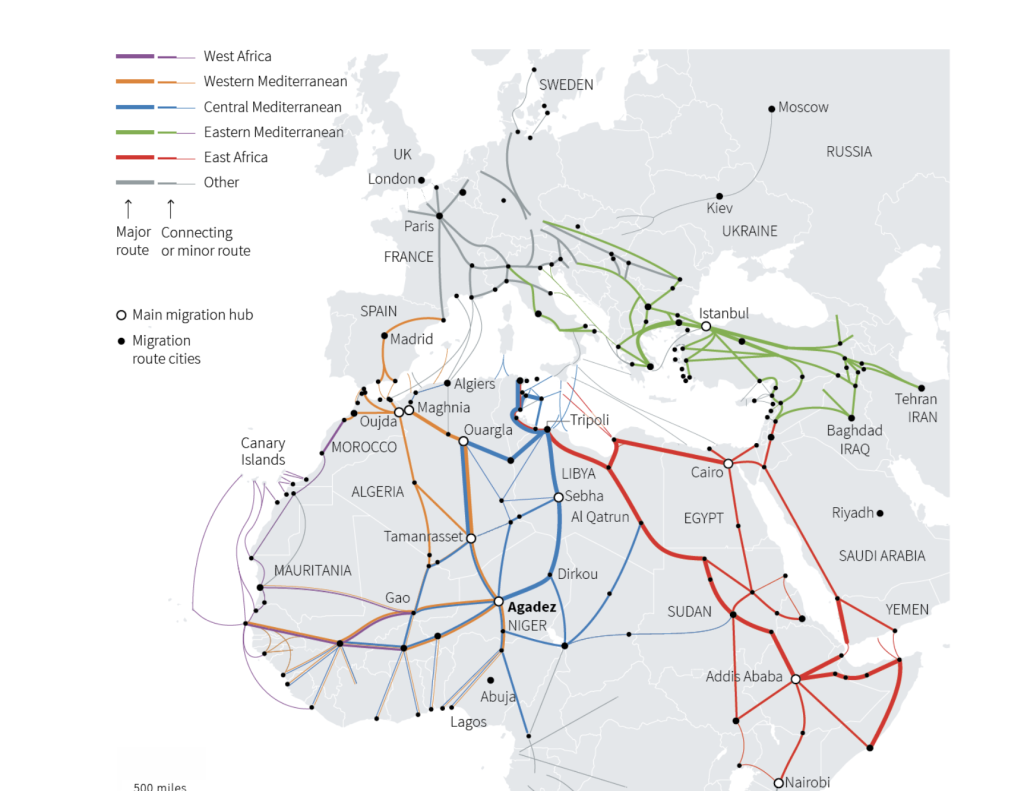
Source: European Commission; International Centre for Migration Policy Development (Map data); International Organization for Migration; Eurostat; UNHCR by Chris Inton, Matthew Weber, Vincent Flasseur, Simon Scarr, Gustavo Cabrera and Travis Hartman. Retrieved from Europe’s migration crisis (2016, Jan. 5)
The free flow of people across the European region has come into question in recent years as northern member states mistrust the vetting process put into place by southern and eastern European states. An individual that manages to enter any of the Schengen states can travel quite easily to any of the other European states. Denmark and Sweden, for example, have increased border security and border checks in spite of being signatories to the agreement. The bold experiment in Europe to integrate so many cultural, linguistic, and political systems faces constant challenges and has no guarantee for long-term success. Twice in the last century, the region was war- torn. As the twenty-first century unfolds, Europe remains a focal point for migration policy and practice into the twenty-second century.
3.3.3 Africa
An average of 78,000 clandestine (illegal) African migrants per year were intercepted on Europe’s southern shores between 2014 and 2019. However, the migration flow to Europe is just one avenue of movement as more than 1 million African economic migrants changed countries within Africa. 1 million migrants per year between 2014 and 2019..
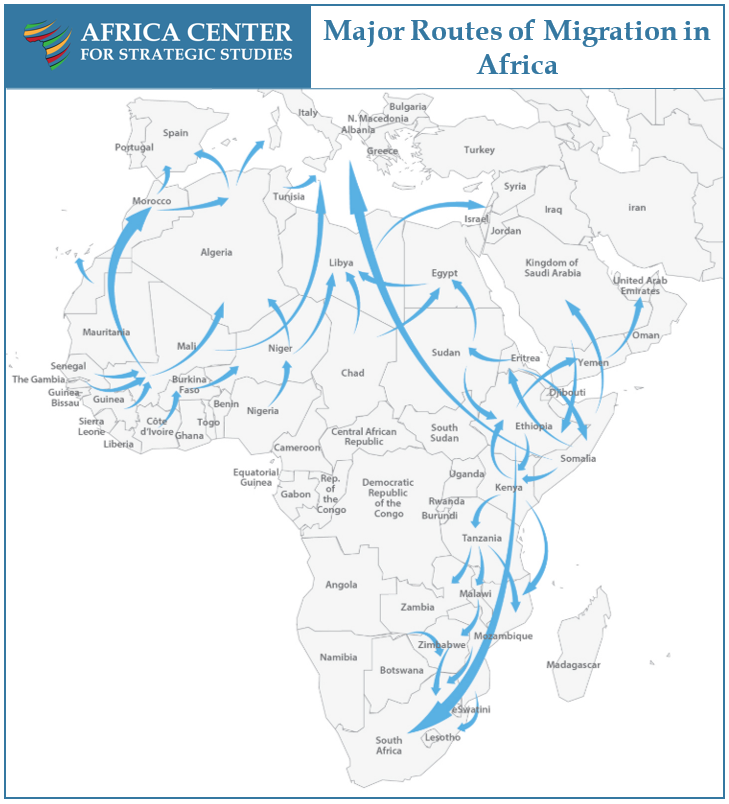
Source: “Major Routes of Migration in Africa” by the Africa Center for Strategic Studies.
Africa in general is the continent with the highest TFR, 4.1 per woman in 2023. Thus the continent is experiencing these clandestine migrant flows because many countries cannot keep up providing education and employment to the young population. As a result, young people from rural areas are increasingly moving to cities and abroad to seek education and work opportunities.
Clandestine migration in Africa has created a lucrative market for human smuggling—estimated to be worth $765 million annually along the Trans-Sahara route alone. Here, many migrants travel with human smugglers in jeep convoys and many such overly packed jeeps and their cargo do not finish the journey.
3.3.4 North America
In North America, about 13.9% of the United States’ population is foreign-born as of 2022. In comparison, about 23% of Canada’s population was foreign-born in 2022 and less than 1% of Mexico’s population was foreign-born in 20202.
Immigration in the United States can be summarized into four phases:
- Phase 1: (1820-1880) Migrants immigrated to the US mainly from Northern and Western Europe. Many new and existing residents migrated to the western states in search of cheap, good farmlands. The Homestead Act of 1862 offered 160 acres of land to citizens and prospective citizens who will live and farm on the land for at least five years.
- Phase 2: (1880-1910) Migrants originated mostly from Southern and Eastern Europe, and worked in coal mines, steel mills, construction, and factories. The Chinese Exclusion Act of 1882 was enacted to prevent the immigration and naturalization of anyone of Chinese descent.
- Phase 3: (1910-1965) Immigration was severely limited by the establishment of a quota system that favored immigrants from Northern and Western European countries over those from Southern and Eastern Europe. Immigrants from all other countries (e.g. Asian countries) were virtually eliminated.
- Phase 4: (1965-now) Past immigration quotas and exclusionary policies were replaced by an immigration system that favors skilled and educated migrants, and the migration of immediate relatives of existing citizens (i.e. family reunification). This led to huge growth in immigration, with most migrants coming from Asia, Latin America, and a greater diversity of countries than ever before.The racist history of US immigration policy (Source: Vox)
3.3.5 Asia
West Asia:The region stretching from Morocco in the Northwestern Africa to Afghanistan in West Asia contains some of the world’s longest-lasting and most deeply entrenched conflicts that generate refugees.
Conflict in Afghanistan has lasted more than 40 years, generating the largest refugee flow in the world today, with a quarter of the refugees worldwide coming from Afghanistan alone. The Gulf War of 1991 and the Iraq War of 2003 produced millions of refugees in the region. In 1991, in the aftermath of the Gulf War that followed Iraq’s invasion of Kuwait, a significant percentage of the Kurdish population of northern Iraq was threatened and s many as 1.85 million people joined this refugee movement.
Thus, economic inequities and ongoing political conflict in West Asia have led to it being home to some of the largest migrant populations globally. In addition, this is an area where ongoing protracted displacement of people (= 25,000 or more refugees from the same nationality have been in exile for five or more years in a given asylum country) is the highest in the world.
The surge in employment opportunities in the six Gulf Cooperation Council (GCC)2 countries following the oil booms attracted millions of labor migrants from within and outside Western Asia. As a share of the total population, the GCC countries continue to host the highest shares of migrants in the world. In addition to millions of Internally Displaced Persons (IDPs) hosted in Western Asia, the subregion also hosts high numbers of refugees.
South Asia: During the Soviet invasion in the 1980s, Pakistan played a significant role in accommodating Afghan refugees, with the United Nations High Commissioner for Refugees (UNHCR) reporting over 3 million refugees in the country. In the 1990s, this number averaged between 1.2 and 1.5 million. The influx increased again when U.S.-led forces began operations against terrorist bases in Afghanistan in October 2001. Currently, Afghanistan faces a massive refugee crisis, with over 2 million Afghans living abroad, primarily in Pakistan and Iran.
Climate change is expected to significantly influence the refugee situation in South Asia in the coming decades. Although its effects will be felt globally, Bangladesh is projected to be the epicenter for climate refugees. With a population of 156.6 million, Bangladesh is situated in a river delta that is one-fifth the size of France. Most of this area lies at an elevation of no more than 6.1 meters (20 feet) above sea level and is crisscrossed by 230 major rivers and streams, making it highly susceptible to flooding and typhoons. Human activities have exacerbated these vulnerabilities; extensive groundwater extraction is causing subsidence in cities, and the destruction of mangroves has heightened erosion rates and eliminated natural storm surge barriers. By 2050, up to 17 percent of the country could be underwater. For years, environmental refugees have been migrating from Bangladesh to neighboring India. However, India is constructing a border wall to prevent further migration. Already dealing with significant demographic challenges, Bangladesh finds itself in an even more vulnerable position due to climate change.
East Asia: Large-scale human settlement and political development occurred much earlier than in Europe or in North America. Early Chinese civilizations had already emerged more than 5,000 years ago, and many in Asia can trace ancestral lineages back thousands of years as well. As such, Asia (for the most part) wasn’t “discovered,” conquered, or colonized during the time of European imperialism. In addition, most Asian countries simply do not allow for permanent immigration, except in the case of marriage. Nonetheless, in the age of globalization and migration, more people are on the move in Asia in the twenty- first century than ever before.
With a population of 1.4 billion and a fast-growing economy, China tends to dominate the East Asia region. The Chinese Diaspora is a term that refers to the 46 million people that identify themselves as Chinese but live outside of China, with the largest number making their homes in Southeast Asia and others in Australia, North America, or Europe. Many fled China during times of political instability before and after WWII and under early communist rule, but today, many of those who leave China are wealthy and educated and do so because their skills are in demand in other parts of the world.
The most significant movement of people anywhere in the history of the world has been taking place recently inside both China and India as rural farmers have been leaving the countryside and moving into cities. Nearly 200 million people have left the interior of China to re-settle and seek work in China’s dynamic cities, mostly located along the eastern part of the country. While they do not cross international borders, the distance and socioeconomic differences between rural and urban areas in China are very similar to an international move for many. The motivation is largely economic in that farmers can barely earn a few dollars a day in rural areas; new manufacturing jobs in coastal cities pay several times that.

